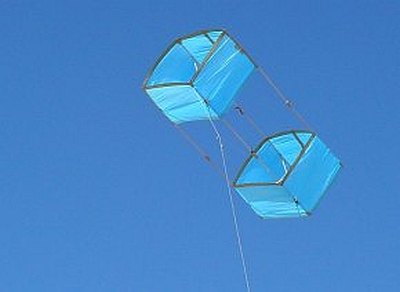- Home Page
- Flight Reports
- Sticked Boxes
- Multi-Dowel Box
Multi-Dowel Box Kite
Successful Test in Plenty of Breeze
Today was the fourth outdoor rig of this large rhomboid kite, but it had yet to fly for more than 10 or 20 seconds at a time. However, there was definitely plenty of breeze on this occasion. We were down at the beach near Fort Glanville at Semaphore.
 MBK Multi-Dowel Box
MBK Multi-Dowel BoxA smooth moderate-strength wind was blowing onshore, and a large mass of rain clouds had recently departed to the east.
After several years of constant kite-making and flying activity, we had finally caught up with some members of the Adelaide Kite Flyers Association (AKFA) at their official flying site.
The site is some
distance from our home in the southern suburbs of Adelaide, but we'll
have to come up more often, I think. It's the second Sunday of each month, all
welcome, if you're in Adelaide and own a kite!
The big blue box
needs a bit of shelter from the wind to get it rigged more easily. Hence
it took shape on the downwind side of the car, in the car park. From
there, it was straightforward to fly it on just a meter (3 feet) or so
of line and walk it down to the sand.
All the while, there were a
few other kites in the air—some traction-kite-powered skateboarding
along the sidewalk (footpath), a colorful rotating HQ Box, and a couple
of single-line parafoils. Note the absence of light-wind kites!
On this site, there's more kite-making info than you can poke a stick at. :-) Want to know the most convenient way of using it all?
The Big MBK E-book Bundle is a collection of downloads—printable PDF files which provide step-by-step instructions for many kites large and small.
That's every kite in every MBK series.
The Multi Dowel Box was really in its element. A smooth moderate-strength wind was gusting just into the fresh range from time to time. Soon after letting out a few meters of line, Tony S. (then president of AKFA) kindly offered a sand anchor to make things more convenient. That's the way to go at a beach site with large kites!
The box was left to its own devices on somewhat less than 30 meters (100 feet) of line, wandering left and right in response to small wind-shifts and gusts.
The Making Box Kites e-book contains ample instructions for putting together one of these kites from oak dowel and plastic. Or you could substitute soft Tyvek.
With the sea water lapping ever closer, there was not a lot of room on the soft sand for long-line flying. That would have taken the kite uncomfortably close to trees and moving cars, in the prevailing wind direction. It would be a different story with a lower tide—not to mention with the wind blowing from just about any other direction!
Eventually, the breeze freshened back up a little, so I whipped out the Windtronic anemometer and held it up. Gust after gust pumped the maximum reading up to 30 kph, with an average of 21 kph. The big blue box was handling it easily, so it should still go OK right up into the 40s.
The oversize horizontal cross-sticks were not budging a millimeter as far as I could tell. If this kite ever gets tested to destruction, perhaps some other piece of dowel will give way first—for a change.
Also in my green bag of tricks was the set of spring scales, so we took a quick line-tension reading.
While Tony pulled some slack into the line, I put seven turns around the hook end of the scales. Then, taking the ring end of the scales in both hands to keep it steady, it was easy to read off the tension. Roughly 4.5 kilograms, gusting up to 6.0 kilograms was the result, which was quite manageable really. I wonder what the Multi-Dowel Sled would have pulled in the same circumstances!
Eventually it was time to leave, so the box was brought down with the aid of a steel carabiner sliding along the line.
The de-rig in soft sand and with the breeze funneling between the dunes was a little chaotic, but we got there. With more practice I'll figure out a routine for getting the box packed away in windy conditions. It was all pretty easy on earlier occasions when there wasn't enough breeze to fly.
All in all, it was a great first flight despite the non-typical low-altitude mooring. There will be plenty of opportunities later to put this kite up on 400 feet or more of line. Being a box, it should cope well with extreme gustiness when flown more inland. As for strong thermal conditions, we might not being seeing them for quite a few months now. Nothing surprises me any more with dowel and plastic kites in thermals. This latest box kite will still go overhead one day!
The story or stories above document actual flying experiences. My write-ups are definitely "warts and all," since things don't always go totally as planned. However, half the fun of kiting is anticipating the perfect flight. When it happens, it's magic!
As mentioned earlier, there's more kite-making info here than you can poke a stick at. :-)
Want to know the most convenient way of using it all?
The Big MBK E-book Bundle is a collection of downloads—printable PDF files which provide step-by-step instructions for many kites large and small.
That's every kite in every MBK series.
